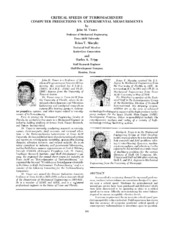| dc.description.abstract | As a result of a continuing demand for increased performance, modern turbomachines are sometimes designed to operate near a critical speed. Machines for petrochemical and natural gas service have been purchased and delivered which were later discovered to be operating so close to a critical speed as to cause difficulty in maintaining the rotor balance required to ensure acceptable vibration levels. A serious requirement for an accurate critical speed prediction capability is thus indicated. Field experience has shown that the accuracy of computer predicted critical speeds of contemporary turbomachines is sometimes open to question. Reports on research to experimentally verify existing computer programs for a priori critical speed prediction are almost nonexistent in the engineering literature. Comparisons of state-of-the-art computer predictions of critical speeds are described herein, with experimental measurements on shafts and rotors of varying complexity. The models investigated range from a precision uniform shaft in the laboratory to an eight-stage centrifugal compressor rotor. Modifications made to existing computer programs to improve the accuracy of predicted critical speeds are also discussed. Special care must be taken to properly define the rotor-mass elastic model, which depends on the features of the computer program employed. The accuracy of critical speed predictions is shown to depend on: 1) the accuracy of the free-free rotor vibration models, which depends on the accuracy of the rotor mass-elastic model, once the computer algorithm is optimized, 2) the accuracy of the bearing stiffness and damping coefficients, which are speed dependent in the case of fluid-film bearings, and 3) the accuracy of the dynamic properties of the foundation, which can be represented by a frequency-dependent impedance and which must be determined by experimental measurements. In the special case of tilt-pad bearings, existing data on the stiffness properties was found to be unsatisfactory. Measurements were made and the new results are reported herein. Measurements made on one of the laboratory models, a three-disk rotor on tilt-pad bearings, showed subsynchronous whirl, which is not explainable by contemporary instability theory unless the tilt-pad bearings have significant cross-coupling and less damping than the available literature predicts. | en |


